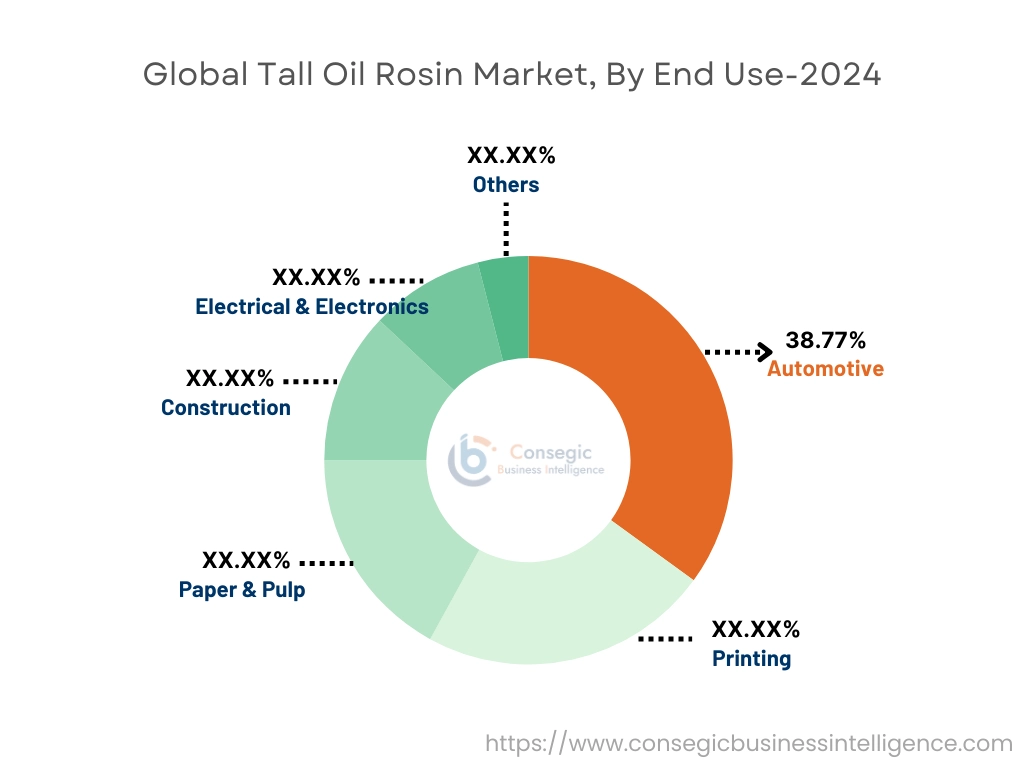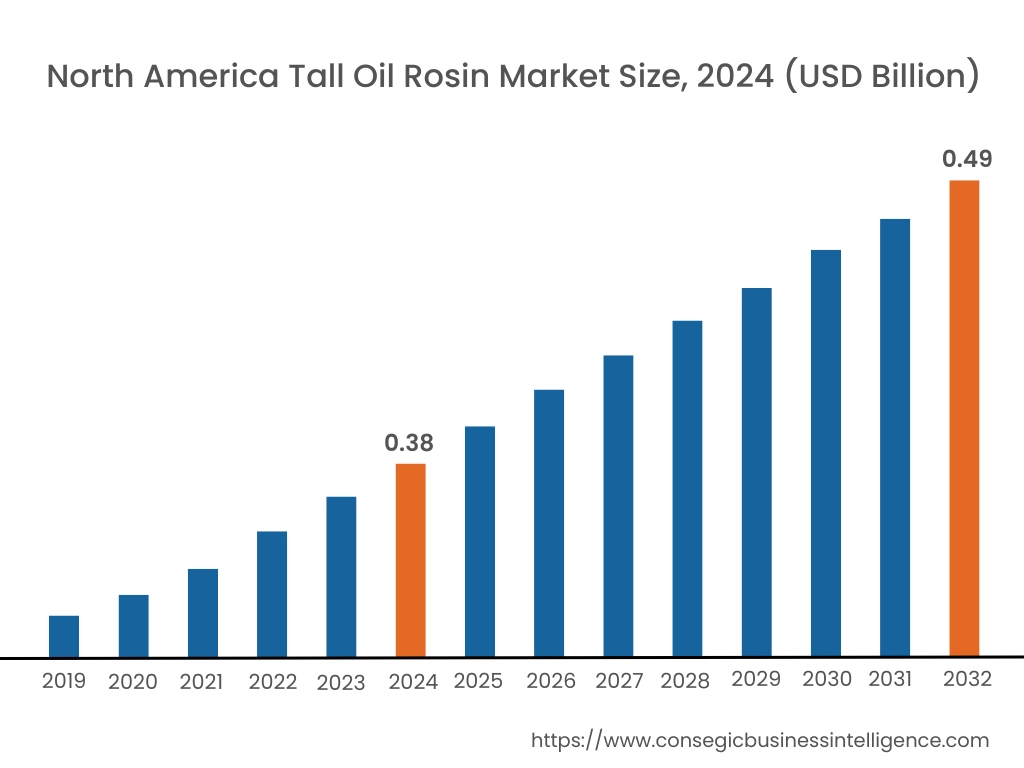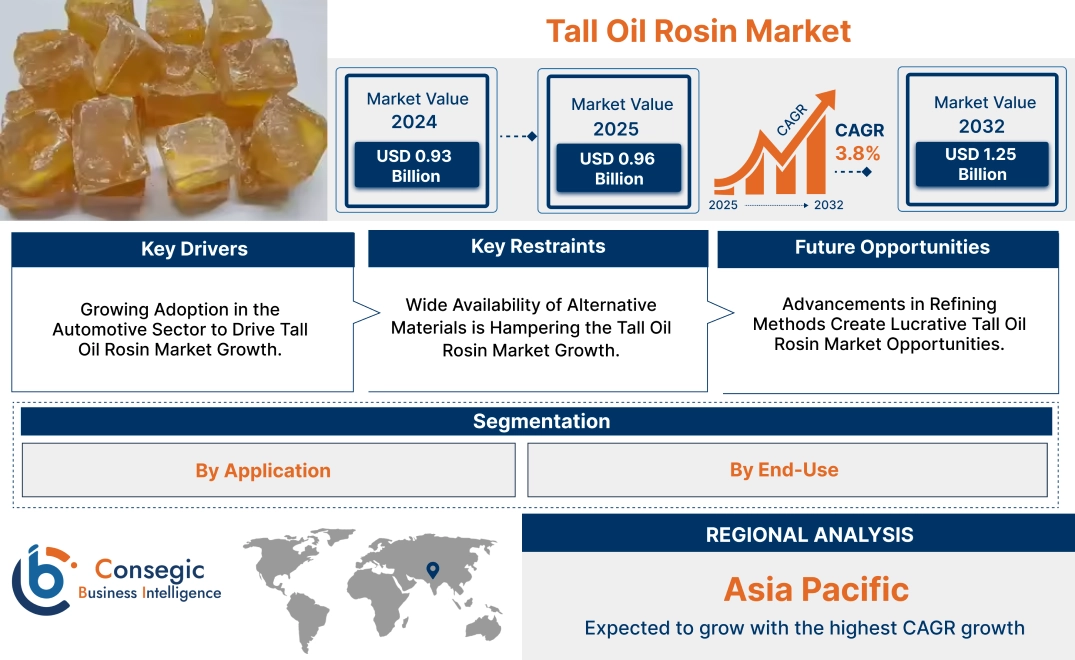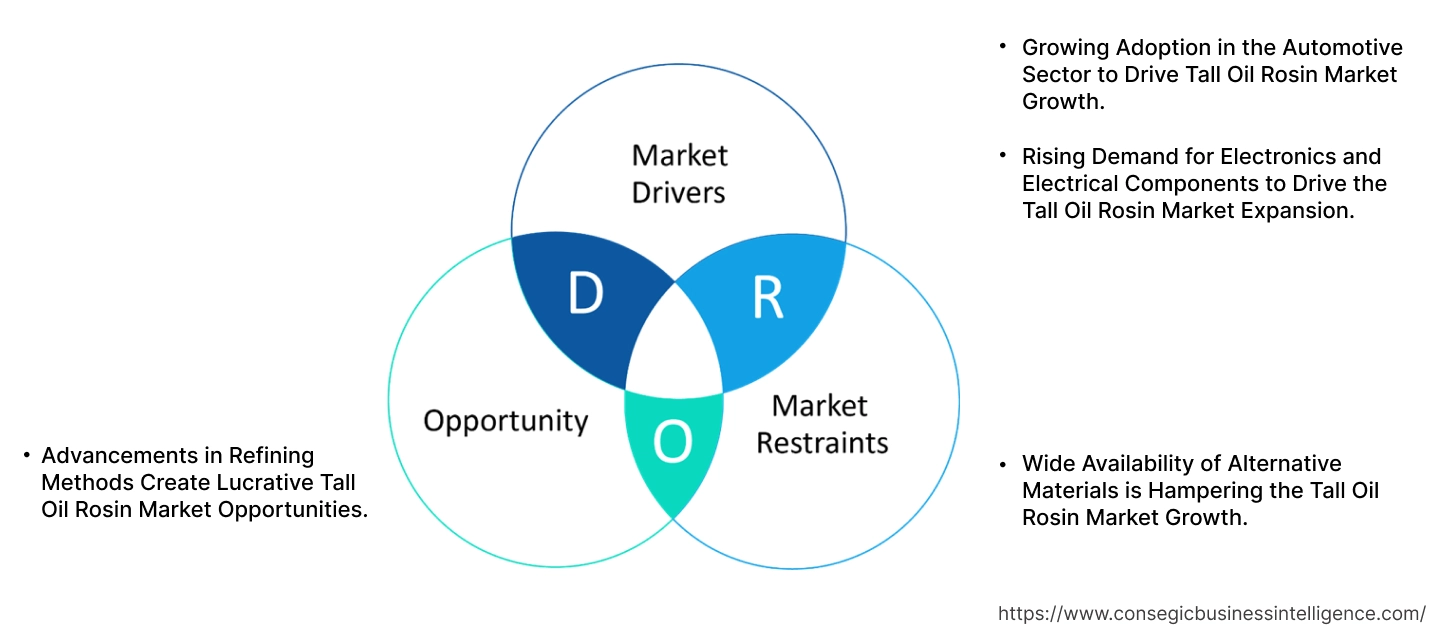Tall Oil Rosin Market Size:
Tall Oil Rosin Market size is growing with a CAGR of 3.8% during the forecast period (2025-2032), and the market is projected to be valued at USD 1.25 Billion by 2032 from USD 0.93 Billion in 2024. Additionally, the market value for the 2025 attributes to USD 0.96 Billion.
Tall Oil Rosin Market Scope & Overview:
Tall oil rosin (TOR) is a natural resin derived from crude tall oil (CTO), a by-product of the Kraft pulping process of coniferous trees. Obtained through the fractional distillation of CTO, TOR is primarily composed of rosin acids, mainly abietic acid and its isomers. This solid, yellowish-to-brown resin is highly known for its inherent tackifying properties. Its bio-based origin and versatile properties contribute to its increasing requirement as industries seek sustainable and effective raw materials. Its primary use lies in adhesives, where its tackifying properties are essential for packaging, construction, and automotive applications. In the printing industry, TOR acts as a crucial binder in printing inks. The automotive sector utilizes rubber compounding to enhance the performance of tires and other rubber components. The paper & pulp industry employs TOR for paper sizing. The compound also finds uses in fuel additives, soldering flux, and as a component in surfactants.
Tall Oil Rosin Market Dynamics - (DRO) :
Key Drivers:
Growing Adoption in the Automotive Sector to Drive Tall Oil Rosin Market Growth.
The tackifying property of the rosin makes it a crucial component in various adhesives used in vehicle assemblies, such as bonding interior parts, sealing, and securing components, contributing to structural integrity and noise reduction. In rubber compounding, it acts as a processing aid, improving the elasticity and overall performance of tires and other rubber components used in vehicles. Additionally, certain tall oil-based chemicals are found in coatings for various EV parts, providing protection against corrosion and wear, and extending the lifespan of components. The expanding automotive production coupled with the ongoing shift towards electric vehicles is generating a requirement for lightweight materials and specialized adhesives and coatings.
For instance,
- According to EVBoosters, China produced around 11 Million EVs in 2024, which is a 40% increase compared to 2023.
Thus, the consumption of these rosins in automotive sector is driving the market growth.
Rising Demand for Electronics and Electrical Components to Drive the Tall Oil Rosin Market Expansion.
Tall oil rosin plays several roles in the electrical and electronics sector, primarily leveraging its adhesive, binding, and fluxing properties. One significant application is in soldering fluxes. Rosin-based fluxes are commonly used in soldering electrical components due to their ability to clean metal surfaces by removing oxides, facilitating the flow of solder, and ensuring a strong electrical connection. These fluxes are preferred because they are only active when heated and are non-conductive and non-corrosive at room temperature, minimizing the risk of short circuits. The rise in the production of electronic components is influencing the use of these rosins.
For instance,
- For instance, according to Entrepreneur Media, LLC, the requirement for sub-assemblies and components contributed to approximately 43% of electronic production across the globe in 2022.
Thus, the growing requirement for consumer electronics is contributing to the tall oil rosin market demand.
Key Restraints:
Wide Availability of Alternative Materials is Hampering the Tall Oil Rosin Market Growth.
The wide array of readily available alternative materials presents a significant hindrance to market expansion. In adhesives, synthetic resins, mainly derived from petroleum, offer compelling cost advantages and are specifically engineered to meet diverse and demanding bonding requirements. Similarly, the printing ink sector benefits from synthetic binders that frequently exhibit superior color stability, faster drying times, and enhanced print quality compared to tall oil rosin. Furthermore, the rubber compounding industry has access to a broad spectrum of synthetic elastomers and other natural resins with well-established supply chains and competitive pricing, mainly providing tailored performance characteristics. Thus, this robust availability of substitutes across key application areas creates downward pressure on the requirement for rosin, limiting its market growth potential.
Future Opportunities :
Advancements in Refining Methods Create Lucrative Tall Oil Rosin Market Opportunities.
Advancements in refining methods are creating lucrative opportunities within the tall oil rosin industry by enabling the production of higher-purity rosin grades with more consistent and tailored properties. These enhanced refining techniques allow for the separation of specific rosin acid isomers and the removal of impurities, resulting in rosin qualities that meet the stringent requirements of high-performance applications. Various techniques involve the recovery of rosins from crude tall oil that allows for various rosin applications.
For instance,
- In 2024, UPM-Kymmene received a grant for their distillation-based method of refining crude tall oil into biofuels. The patented process includes recovering tall oil rosin fractions and subsequently producing rosin soap from these recovered fractions.
Thus, the advancement in refining methods creates lucrative tall oil rosin market opportunities.
Tall Oil Rosin Market Segmental Analysis :
By Application:
Based on the application, the market is categorized into adhesives, printing ink, rubber compounding, paper sizing, fuel additives, soldering flux, surfactants, and others.
Trends in the application:
- The trend for lightweight materials incorporated into adhesives for interior parts, trim, and structural bonding in vehicles is influencing the use of rosins.
- The growing trend for eco-friendly printing agents is influencing the use of rosins in them.
The adhesives segment accounted for the largest market share in 2024.
- Tall oil rosin is a significant component in various adhesive formulations, primarily acting as a tackifier.
- Its inherent stickiness and ability to improve the adhesion of other polymers make it valuable in a wide range of adhesive types, including pressure-sensitive adhesives used in tapes and labels, hot-melt adhesives used in packaging and bookbinding, and solvent-based adhesives used in construction and industrial applications.
- The compound enhances the initial grab and peel strength of adhesives, ensuring a strong bond formation.
- The rise in the manufacturing of adhesives influences the rise in the development of new manufacturing facilities that use this compound.
- For instance, in 2022, Henkel opened a new plant in Guadalupe, Mexico, that will boost production of their Technomelt hot melt adhesives, including high-performance SUPRA and energy-saving COOL portfolios, catering to a growing requirement for efficient bonding solutions.
- Thus, based on the market analysis, the rise in the use of rosins in adhesives is fueling the Tall Oil Rosin market trends.
The printing ink segment is expected to grow at the fastest CAGR over the forecast period.
- Printing ink represents a significant and expanding application for oil rosin driven by several factors.
- It acts as a crucial binder resin in various types of printing inks, providing essential properties like pigment wetting, adhesion to the substrate, and gloss.
- The increasing requirement for printed materials in packaging, labels, and publications, coupled with a growing preference for bio-based and sustainable ingredients, positions the solution as a valuable alternative to some synthetic resins.
- Furthermore, as per the market analysis, ongoing research is exploring modified TOR derivatives to enhance ink performance characteristics like drying speed and rub resistance, thus opening up new prospects in higher-performance printing ink segments.
By End-Use:
Based on the end use, the market is categorized into automotive, printing, paper & pulp, construction, electrical & electronics, and others.
Trends in End Use:
- There is a rise in trends for sustainable materials, and high-performance adhesives and coatings are driving a trend towards greater utilization of rosins.
- Advancements in bio-based printing inks influence the use of rosins in them.
The automotive segment accounted for the largest Tall Oil Rosin market share of 38.77% in the year 2024.
- In the automotive sector, tall oil rosins find applications primarily in adhesives, coatings, and rubber components.
- They enhance the adhesion in interior adhesives and contribute to the durability and weather resistance of automotive coatings.
- Furthermore, it is also used in rubber compounds for tires and other parts, influencing their performance characteristics.
- The rise in the adoption of automotives such as EVs is influencing the use of this solution.
- For instance, the data published in IEA states that the share of electric cars in total sales increased by 4% in 2020 to 18% in 2023.
- Thus, as per the market analysis, the rise in adoption of rosins in automotives is driving the growth of the segment.
The printing segment is expected to grow at the fastest CAGR over the forecast period.
- The printing ink sector is undergoing significant transformations.
- Methods like lithography and flexography are the primary consumers of rosin-based inks.
- Additionally, the increasing requirement for eco-friendly inks and the ability of TOR-based formulations to meet the performance and cost requirements of these specific printing applications is influencing the use of this solution.
- As environmental regulations become stricter and consumer preferences shift towards eco-friendly products, ink manufacturers are actively seeking renewable alternatives to traditional petroleum-based resins and binders.
- Thus, as per the market analysis, the growing use of the solution in printing applications is influencing the Tall Oil Rosin market demand in the coming years.

Regional Analysis:
The regional segment includes North America, Europe, Asia Pacific, the Middle East and Africa, and Latin America.

In 2024, North America accounted for the highest Tall Oil Rosin market share at 41.21% and was valued at USD 0.38 Billion and is expected to reach USD 0.49 Billion in 2032. In North America, the U.S. accounted for the highest market share of 71.11% during the base year of 2024. The increasing adoption of electric vehicles (EVs) in North America presents an evolving landscape for the use of TOR. The resin's role as a bio-based tackifier in adhesives for interior components, tires, and coatings for various parts aligns with the automotive sector's increasing focus on sustainability. The rise in adoption of Electric vehicles in this region is influencing the use of this solution.
For instance,
- The data by Select USA states that the United States represents a substantial global automotive market, ranking as the second largest for both vehicle sales and production. In 2022, the country recorded 11.5 million new light vehicle sales, highlighting its significant consumption and manufacturing presence in the automotive sector.
Thus, as per the tall oil rosin market analysis, the rise in the adoption of automotive is influencing the use of rosins in them.

Asia Pacific is experiencing the fastest growth with a CAGR of 5.1% over the forecast period. Advancements in refining technologies within the Asia Pacific region are significantly enhancing the quality and expanding the potential applications of oil rosin. Innovations in distillation and separation techniques are enabling the production of these solutions with higher purity levels, improved color grades, and consistent properties. This allows the resin to meet the increasingly stringent requirements of various downstream industries in the region, such as high-performance adhesives for the electronics and automotive sectors, specialized printing inks with better adhesion and stability, and advanced rubber compounding for tires and industrial applications. Thus, as per the market analysis, the aforementioned factors are influencing the market growth in this region.
In the European region, tall oil rosin finds applications within the electrical and electronics components sector, primarily leveraging its properties in soldering fluxes. Rosin-based fluxes, including those derived from this resin, are utilized to clean metal surfaces by removing oxides, which is crucial for ensuring strong and reliable electrical connections during soldering processes in the manufacturing of various electronic devices. These fluxes are favored for their activity under heat and their inert, non-conductive nature at room temperature, minimizing the risk of short circuits. As consumer preferences shift towards sustainable products, the requirement for Oil Rosin is expected to continue to grow in the European market.
The Middle East and Africa (MEA) region is witnessing a surge in the requirement for Tall Oil Rosin, driven by factors like increasing demand for personalization and technological advancements. The increasing requirement for sustainable and bio-based inks, as well as the ability of the resin to compete with other synthetic and natural alternatives in terms of cost and performance within the regional ink manufacturing sector is influencing the use of this resin. Infrastructure development and increasing packaging demands also boost the use of resin inks for these applications within the MEA region. Thus, as per the tall oil rosin market analysis, these aforementioned factors are influencing the Tall Oil Rosin market trends.
The construction sector in Latin America presents potential for tall oil rosin use due to increasing urbanization and infrastructure development across the region. The resin's adhesive and binding properties make it a valuable component in various construction materials. It is utilized in the production of adhesives for bonding wood, flooring, and other building materials, as well as in sealants and coatings for protecting surfaces from weathering and corrosion, crucial in the diverse climates of Latin America. Thus, the use of resin in construction drives the tall oil rosin market expansion in this region.
Top Key Players and Market Share Insights:
The global Tall Oil Rosin market is highly competitive with major players providing precise products to the national and international markets. Key players are adopting several strategies in research and development (R&D) and product innovation to hold a strong position in the global Tall Oil Rosin market. Key players in the Tall Oil Rosin industry include-
- Pine Chemical Group (Finland)
- Kraton Corporation (United States)
- Ingevity (United States)
- Ilim Group (Russia)
- Forchem (Finland)
- Sibles LLC (Russia)
- Harima Chemicals Group, Inc. (Japan)
- Neste (Finland)
Tall Oil Rosin Market Report Insights:
| Report Attributes | Report Details |
| Study Timeline | 2019-2032 |
| Market Size in 2032 | USD 1.25 Billion |
| CAGR (2025-2032) | 3.8% |
| By Application |
|
| By End-Use |
|
| By Region |
|
| Key Players |
|
| North America | U.S. Canada Mexico |
| Europe | U.K. Germany France Spain Italy Russia Benelux Rest of Europe |
| APAC | China South Korea Japan India Australia ASEAN Rest of Asia-Pacific |
| Middle East and Africa | GCC Turkey South Africa Rest of MEA |
| LATAM | Brazil Argentina Chile Rest of LATAM |
| Report Coverage |
|
Key Questions Answered in the Report
How big is the Tall Oil Rosin market? +
In 2024, the Tall Oil Rosin market is USD 0.93 Billion.
Which is the fastest-growing region in the Tall Oil Rosin market? +
Asia Pacific is the fastest-growing region in the Tall Oil Rosin market.
What specific segmentation details are covered in the Tall Oil Rosin market? +
Application and End Use segmentation details are covered in the Tall Oil Rosin market.
Who are the major players in the Tall Oil Rosin market? +
Pine Chemical Group (Finland), Kraton Corporation (United States), Forchem (Finland) are some of the major players in the market.


